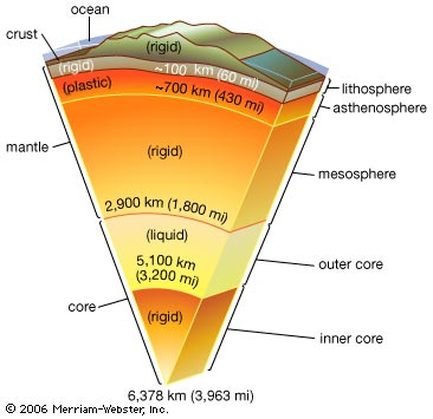Order the following from longest to shortest:
period, epoch, era, eon
eon, era, period, epoch
What are the 3 rock types?
Igneous, metamorphic, sedimentary
What is an outcrop?
A part of a rock formation that appears above the surface of the surrounding land
What is a half-life?
The amount of time that it takes one half of the parent radioactive atoms to decay into daughter isotopes. Every radioactive isotope has a specific half-life.
What machine records earthquake waves?
Seismograph
The era that spans the greatest geological time in Earth's History is...
Precambrian era
What are 4 types of fossils?
mould, cast, trace, body/fossil remains
What is the semiplastic layer of earth that tectonic plates move across called?
Asthenosphere
What is an isotope?
Two or more forms of the same element that contain equal numbers of protons but different numbers of neutrons in their nuclei.
which type of wave travels the slowest?
Surface wave
The geological eras in order from oldest to most recent are....
Precambrian, Paleozoic, Mesozoic, Cenozoic
Which type of igneous rock will have larger crystals--intrusive or extrusive?
Intrusive
Which plate boundary results in the destruction of crust?
convergent (subducting)
What is the half-life for the following unknown element?

8 days
If a seismograph determines that the time between p and s-waves is 55 seconds, how far away is the station from the epicentre?

540 km
What microorganism left behind fossilized structures called stromatolites?
cyanobacteria
What are the three things that make a good trace fossil?
Distinctive (easily recognizable)
Abundant (many fossils can be found)
Wide geographic distribution over short time
How we know that the Earth's magnetic poles have reversed multiple times throughout geological history?
Paleomagnetism

Radio carbon dating is done by estimating in a specimen:
a.) The amount of ordinary carbon still present.
b.) The amount of radiocarbon still present.
c.) The ratio of the amount of C-14 to C-12 still present.
d.) The ratio of the amount of C-12 to C-14 still present.
c.) The ratio of the amount of C-14 to C-12 still present.
What type of earthquake wave is a transverse wave?
S-waves
What geological formation is proof of primordial earth's oxygen rich atmosphere?
Banded-iron formations
A rock is formed through immense heat and pressure. The rock is part of an oceanic tectonic plate that subducts under a continental plate, resulting in the rock melting. The magma it is a part of pushes up through cracks in the crust above it until it is part of the upper lithosphere. Water and wind erode the rock, and it's fragments are carried away where they settle at the bottom of a river. As more sediments pile on top of it, the weight compacts the fragments, cementing them into a solid rock again. What is the capital of Alberta spelt backwards?
NOTNOMDE
What are the 4 layers of earth listed from thickest to thinnest?
Mantle, outer core, inner core, crust

A geologist determines the percentage of uranium-238 and lead-206 found in a titanite. She finds that 88% of the sample is lead-206. Determine the age of the titanite.

Approximately 13 billion years old.
1.3 x 10^10 a
Explain how seismic waves are used to locate oil.
Answers will vary, must include reference to geophones (vibrator truck, detector truck, geophones spread out collecting refracted and reflected waves)